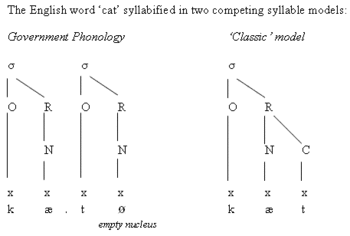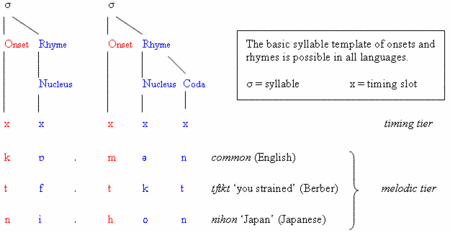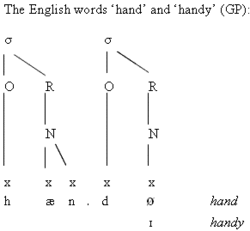Syllable
The syllable is a unit of organisation in phonology, the study of the patterns of sounds and signs in language. Typically, a syllable consists of a vowel and at least one consonant, though various combinations are possible, including single vowels. The number and type of syllables in a word, phrase or sentence may strongly influence stress and intonation throughout.
In linguistics, the existence of syllables as organisers of speech sounds and sign language movements is typically used to explain observations about what is possible in language, from native speakers’ perceptions of how many 'beats' there are in a word to the possible ordering of segments such as c, a and t in cat: why English speakers 'feel' there are two syllables in mother but only one in fire, and why *nxalr is not a possible word in English and, indeed, most languages.
The existence of the syllable as an abstract phonological unit that limits the possible sequences of segments is not uncontroversial, and its use in mainstream linguistics literature has been inconsistent. Theories predating the arrival of the currently-mainstream generative phonology, as well as more recent approaches from within generativism itself, have called into question or even outright rejected the syllable in favour of other behavioural explanations from within both phonology and phonetics.
Syllable structure
The structure of the syllable has been described in several different ways, but the 'classic' model is as follows (see historical definitions of the syllable below).
The 'classic' model
- Onset: one to three consonants beginning the syllable, such as [s] in sit or [bl] in blog.[1] In languages such as German and Limbu,[2] all syllables must have onsets.[3][4]
- Rhyme:
- Nucleus: the 'peak' of the syllable, required in all languages. Vowels are automatically nuclei, but in some languages, including English, syllabic consonants are possible - for instance, the [n] of [bʌtn] button forms the nucleus of the word's second syllable.[5] The nucleus contains two positions, permitting long vowels and diphthongs, but some languages allow only short vowels. Many languages allow syllables to begin with the nucleus; English ape, for instance, has no onset.
- Coda: consonants closing the syllable; in some accounts, up to five are possible, as in the German du kampfst 'you struggle'. Many languages severely restrict the number and possible coda consonants (for example, Japanese allows only [n] word-finally), and some disallow them completely (Hawaiian).[6]
The range of syllables is denoted using C (for consonant) and V (vowel); for example, the maximal syllable in English is CCCVVCCCC, though no word currently makes use of every position. Spread has three onset consonants,[7] texts has four coda consonants, although some are prone to deletion. Some languages, such as Hawaiian, are 'strict-CV' so allow only a single onset and one vowel. No language disallows onsets altogether.
Branching
Where two segments occupy the onset, rhyme, nucleus or coda, the constituent is said to be branching, like branches of a tree. The onset and nucleus both branch in the English train, for example. Onsets containing two segments are often referred to as binary: for example, [tɹ] in train is a 'binary onset'.
For a language to have branching constituents, single constituents must also exist as a prerequisite; so if a linguist observes words in a language beginning with pr-, for example, they will predict that words beginning with a single consonant, such as p-, are possible, because no language would have branching onsets without single onsets (see markedness). Branching structures are more likely to lead to the syllable being stressed in some languages, including English.
Onset and rhyme: why splitting the syllable is necessary
Phonological inquiry provides some evidence for splitting the syllable into two main constituents, with the nucleus and coda sharing the rhyme. Broadly, the nucleus and coda seem to mutually affect one another, in that rules that apply to one may affect the other. Such a relationship cannot be easily established for the onset and rhyme, implying a crucial separation.
Stress and 'syllable weight'
To see how stressing of syllables supplies some evidence for the onset-rhyme distinction, consider (1) and (2) below:
- 1) [ kəm . ˈpjuː . tə ] computer
- 2) [ kə . ˈɹ ʌp . ʃən] corruption
In these English examples, the medial syllables in corruption and computer both carry main stress, even though one ends with only a vowel, and the other a vowel and a consonant. So, sequences of long vowels and vowels and consonants in the rhyme behave identically as far as the stress system is concerned. That a long nucleus (e.g. [uː]) 'attracts' the same stress as a short nucleus plus a coda (such as [ʌp]) implies that at some level, the nucleus and the coda are treated as the same constituent, i.e. the rhyme.
A slightly different perspective on these examples is to describe their behaviour in terms of syllable weight and branching of the rhyme or nucleus (see Branching above). As branching occurs in the second syllables of corruption and computer, stressing is triggered. These are known as heavy syllables, because they contain a VV nucleus and, in some languages such as English, a VC rhyme. A V syllable, in contrast is light and does not attract stress in languages that consider this 'syllable weight' in computing which syllable has main stress.
Restrictions on segments
Some other evidence for treating onsets and rhymes differently involves what segments can legitimately occupy these constituents; in many languages only sonorant segments such as vowels and nasals are permitted inside the rhyme, for example in Mandarin. In contrast, a much wider range of consonants, including obstruents (segments involving an obstruction in articulation, such as [p] and [v]), are found in the onsets of the world's languages. English, for instance, permits all its consonants other than [ŋ] to form an onset.
Evidence for the syllable
- Main article: Evidence for the syllable
Evidence for the existence of syllables as significant structures in the world's languages can be divided into evidence both external and internal to the system of language. The former refers to ideas about syllables in various cultures, such as their use in poetry, as well as speakers' 'intuitions' about them. Internal evidence refers to actual linguistic behaviour (e.g. positions where speakers modify a pronunciation), which can perhaps be better accounted for if it is assumed that 'rules' of phonology operate within the syllable rather than some other domain.
There are several pieces of external evidence for the syllable:
- Its place in various cultures around the world; for instance, there are many writing systems, known as syllabaries, that write syllables rather than individual phonemes (distinctive segments);
- Their use in language games, such as Pig Latin, where syllables are moved around;
- Native speaker intuitions; people often 'feel' that words are not the fundamental unit of speech, but are further divided into smaller units;
- Speech errors and wordplay seem to keep respect the position of segments within the syllable; e.g. town drain is a possible spoonerism for down train, because only onsets are swapped, but *nown traid is not;
- Typology (language classification according to structure): most languages seem to have syllables, and certain types are particularly common.
Internal evidence involves a more complex analysis of linguistic behaviour. For example, word stress in many languages seems dependent on the number and type of syllables, and the ordering of speech segments tends to group into syllable-like sequences of consonants and vowels, typically CV.
Historical definitions of the syllable
Although humankind has been aware of syllables throughout recorded history, as evidenced by the existence of syllabaries, a formal definition remained elusive until the late 20th century. Sometimes the syllable was defined on loosely phonetic grounds, while on other occasions a more phonological description was sought.
The syllable in phonetics
The structuralist linguist Charles F. Hockett, drawing on the 1947 work of Kenneth and Eunice Pike, referred to the syllable as a "structural unit", analysing it into Immediate Constituents (capitalisation in original) of an onset, a peak and a coda.[8] He went on to claim that their origin was phonetic and pulmonic (of the lungs): it appeared that the rhythm of pulmonic exhalation correlated with the production of syllables.[9] This was a similar view to the idea that syllables were associated with 'chest pulses'.[10]
However, this phonetic definition of the syllable did not adequately describe its behaviour. Whilst phonetic analysis of speech often finds a correlation between breaks in voicing and syllable margins, there are many instances where boundaries are absent from the acoustic waveform.[11] As a result of this lack of correspondence between phonetic observations and phonological operations, a satisfactory acoustic or auditory definition is yet to be found.[12] Furthermore, changes in pronunciation within syllables often seem unmotivated by phonetic factors; for example, English speakers vary a good deal in how much and when they glottalise the phoneme /t/ in words such as hat; this process occurs syllable-finally, but is not obligatory.[13]
The syllable in generative phonology
The 1950s and 1960s saw a new approach to language study: generative linguistics, associated primarily with Noam Chomsky and his contemporaries. This ultimately became the current 'mainstream' of Western linguistic research, leading to theories of both syntax and phonology. Within generative theory, prosodic structure (levels of phonological information, from the segment up to the syllable and the intonation pattern imposed on an utterance) is formed according to the principles of 'Universal Grammar' (UG), which underlie all languages.[14] A speaker of a language possesses some kind of faculty which explicitly sets out what kinds of syllables, patterns of segments and other levels of phonological information are possible, while ruling out those which are not. This, crucially, unfolds in neurologically typical children without instruction, and little influence from the environment around them. For example, children typically produce syllables of consonant-vowel (CV) sequences from their earliest productions. However, this presence of the syllable in first language acquisition did not immediately lead to its recognition as a crucial unit of phonological theory.
The syllable as a segmental rule
By the time of Chomsky and Halle’s Sound Pattern of English[15] (henceforth 'SPE'), the syllable had been abandoned as a formal phonological unit.[16] In SPE the syllable was not explicitly referred to except as the segmental rather than prosodic feature [± syllabic], attached to vowels and syllabic consonants.[17] However, though there was nothing in SPE between the word and the segment, one could infer the existence of the syllable from rules which seemed to take the syllable as their domain of application.[18] For example, a rule in SPE which seems to apply both to word-edges and adjacent consonants becomes suddenly transparent if it is assumed that it activates at the edge of the syllable.[19] An example of this is glottalisation in English, where the /t/ in but, butter and bottle may be glottalised by many speakers. Assuming this occurs at the right edge of the syllable covers what might otherwise be regarded as three separate rules.
In the 1970s, the syllable was reintroduced to generative linguistics as a rule inserting boundaries between segments.[20] The syllable had returned as a formal linguistic reality, but remained tied to the segmental level.
The syllable as a suprasegmental
By the 1980s, the theory that the syllable was confined to the segmental tier - i.e. that certain segments such as vowels could be inherently syllabic - had been eroded. The syllable came to be seen as a separate 'suprasegmental' unit of organisation, i.e. segments could be grouped inside a syllable but not form the structure of the syllable itself.[21] While one avenue of inquiry questioned whether the syllable was a true linguistic universal at all,[22] the majority of phonologists found the syllable invaluable in describing and predicting data. Assuming the syllable to both exist and be a suprasegmental unit allowed for a more productive description of permissible segmental ordering.[23]
Challenges to the 'classic' model

The traditional model of a syllable as onset, nucleus and coda united in one unit has been challenged in various ways, particularly since the 1990s. Some approaches assume the 'classic' model but modify it; for example, by linking initial and final consonants directly to the syllable itself rather than subsuming them under the intermediate onset and coda constituents.[24] In this version, the syllable consists of a nucleus and optional final consonants within the rhyme, with any pre-nucleic consonants on the same level as the rhyme.
The theory of government phonology (GP) is still more radical[25]. This view denies that syllables exist as organising units in their own right; appealing to an 'onset-rhyme constituent' is enough. In other words, phonological rules that supposedly apply to syllables can be better-described as applying to onsets, rhymes or both. Furthermore, final consonants are analysed not as part of the rhyme and/or coda, but as onsets - of 'covert' final syllables. Compare the GP approach to syllabifying the words 'cat' with the traditional model (right).
GP does not completely abolish rhymal consonants: in cases where a sequence of final consonants could not form a normal onset - such as in hand, where *[nd-] could not begin an English syllable - the consonant cluster is broken up as it would be if the two consonants occurred in different syllables: in panda the [n] and [d] occupy separate syllables, so this must also apply to final [-nd] sequences. Note that this means there is no prosodic difference between hand and handy; the addition of -y requires only that the vowel be 'plugged' into the existing syllable structure, rather than requiring a resyllabification rule to produce a new structure. The cost of extra 'covert' structure of phonetically unrealised syllables is met through not having to invoke rules of syllabification when an ending is affixed. This means, of course, that the underlying syllable structure may contrast sharply with speakers' intuitions about how many syllables a word has.
Footnotes
- ↑ All languages require onsets to be the initial constituent of the syllable; this is regardless of whether the language is written left to right, right to left or top to bottom.
- ↑ Spoken in Nepal.
- ↑ Although German has many words that begin with a vowel, phonetically a glottal stop is inserted to comply with this obligatory onset rule, except in cases where another consonant is resyllabified to occupy another's onset position as in, hab ich 'have I'.
- ↑ In some models, all varieties of Chinese are considered to have obligatory onsets; see Duanmu (2007).
- ↑ The spelling of button misleadingly implies that for most speakers there are two vowels in the word.
- ↑ Languages allow more codas word-internally than word-finally. Both Japanese and Italian allow a full range of consonants inside the word, e.g. Italian ditta 'office' and Japanese datte 'even (if)', though in the latter case they must be part of a long consonant (a geminate). Italian word-final codas are restricted to grammatical function words such as nel 'in the' and loanwords.
- ↑ Some accounts place [s] outside the onset in words such as spread, because it syllabifies differently to 'true' onset consonants; cf. aspect and appraisal.
- ↑ Pike & Pike (1947); Hockett (1955: 150-151).
- ↑ Hockett (1958: 64).
- ↑ Stetson (1951), as reported in Bell & Hooper (1978: 18).
- ↑ Fujimura & Erickson (1997: 99).
- ↑ Laver (1994: 114).
- ↑ A rule which is not necessitated by the facts of phonetics is not "phonetically natural" (Bell & Hooper, 1978: 7).
- ↑ Chomsky (1965).
- ↑ Chomsky & Halle (1968).
- ↑ Kohler (1966).
- ↑ Bell and Hooper (1978: 5).
- ↑ Fischer-Jørgensen (1975: 207); van der Hulst and Ritter (1999: 19).
- ↑ Blevins (1995: 209).
- ↑ Hooper (1972).
- ↑ Selkirk (1984a: 22).
- ↑ Hyman (1983).
- ↑ Selkirk (1984b).
- ↑ Blevins (1995: 216).
- ↑ van der Hulst & Ritter 1999

